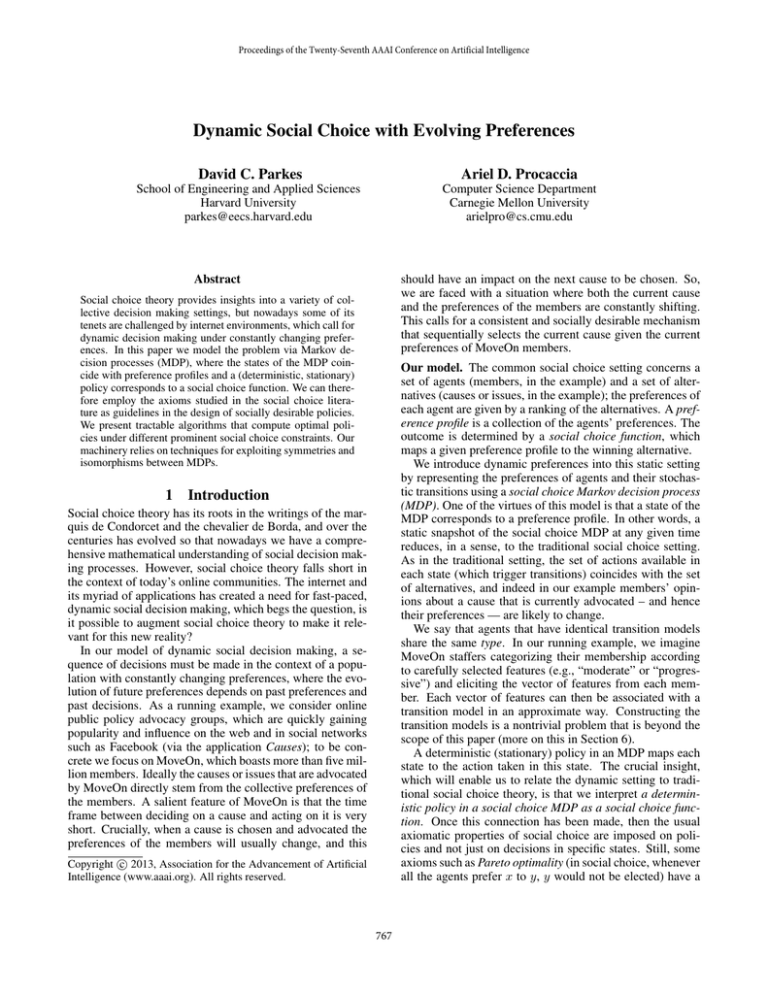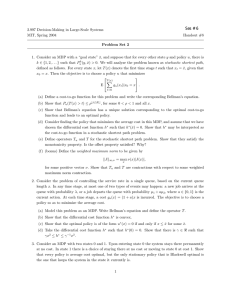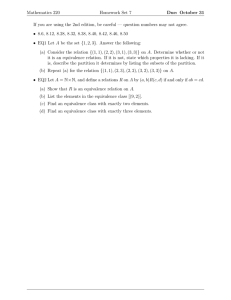
Proceedings of the Twenty-Seventh AAAI Conference on Artificial Intelligence
Dynamic Social Choice with Evolving Preferences
David C. Parkes
Ariel D. Procaccia
School of Engineering and Applied Sciences
Harvard University
parkes@eecs.harvard.edu
Computer Science Department
Carnegie Mellon University
arielpro@cs.cmu.edu
Abstract
should have an impact on the next cause to be chosen. So,
we are faced with a situation where both the current cause
and the preferences of the members are constantly shifting.
This calls for a consistent and socially desirable mechanism
that sequentially selects the current cause given the current
preferences of MoveOn members.
Social choice theory provides insights into a variety of collective decision making settings, but nowadays some of its
tenets are challenged by internet environments, which call for
dynamic decision making under constantly changing preferences. In this paper we model the problem via Markov decision processes (MDP), where the states of the MDP coincide with preference profiles and a (deterministic, stationary)
policy corresponds to a social choice function. We can therefore employ the axioms studied in the social choice literature as guidelines in the design of socially desirable policies.
We present tractable algorithms that compute optimal policies under different prominent social choice constraints. Our
machinery relies on techniques for exploiting symmetries and
isomorphisms between MDPs.
1
Our model. The common social choice setting concerns a
set of agents (members, in the example) and a set of alternatives (causes or issues, in the example); the preferences of
each agent are given by a ranking of the alternatives. A preference profile is a collection of the agents’ preferences. The
outcome is determined by a social choice function, which
maps a given preference profile to the winning alternative.
We introduce dynamic preferences into this static setting
by representing the preferences of agents and their stochastic transitions using a social choice Markov decision process
(MDP). One of the virtues of this model is that a state of the
MDP corresponds to a preference profile. In other words, a
static snapshot of the social choice MDP at any given time
reduces, in a sense, to the traditional social choice setting.
As in the traditional setting, the set of actions available in
each state (which trigger transitions) coincides with the set
of alternatives, and indeed in our example members’ opinions about a cause that is currently advocated – and hence
their preferences — are likely to change.
We say that agents that have identical transition models
share the same type. In our running example, we imagine
MoveOn staffers categorizing their membership according
to carefully selected features (e.g., “moderate” or “progressive”) and eliciting the vector of features from each member. Each vector of features can then be associated with a
transition model in an approximate way. Constructing the
transition models is a nontrivial problem that is beyond the
scope of this paper (more on this in Section 6).
A deterministic (stationary) policy in an MDP maps each
state to the action taken in this state. The crucial insight,
which will enable us to relate the dynamic setting to traditional social choice theory, is that we interpret a deterministic policy in a social choice MDP as a social choice function. Once this connection has been made, then the usual
axiomatic properties of social choice are imposed on policies and not just on decisions in specific states. Still, some
axioms such as Pareto optimality (in social choice, whenever
all the agents prefer x to y, y would not be elected) have a
Introduction
Social choice theory has its roots in the writings of the marquis de Condorcet and the chevalier de Borda, and over the
centuries has evolved so that nowadays we have a comprehensive mathematical understanding of social decision making processes. However, social choice theory falls short in
the context of today’s online communities. The internet and
its myriad of applications has created a need for fast-paced,
dynamic social decision making, which begs the question, is
it possible to augment social choice theory to make it relevant for this new reality?
In our model of dynamic social decision making, a sequence of decisions must be made in the context of a population with constantly changing preferences, where the evolution of future preferences depends on past preferences and
past decisions. As a running example, we consider online
public policy advocacy groups, which are quickly gaining
popularity and influence on the web and in social networks
such as Facebook (via the application Causes); to be concrete we focus on MoveOn, which boasts more than five million members. Ideally the causes or issues that are advocated
by MoveOn directly stem from the collective preferences of
the members. A salient feature of MoveOn is that the time
frame between deciding on a cause and acting on it is very
short. Crucially, when a cause is chosen and advocated the
preferences of the members will usually change, and this
c 2013, Association for the Advancement of Artificial
Copyright Intelligence (www.aaai.org). All rights reserved.
767
Dynamic preferences can also be found in papers on iterative voting (see, e.g., Meir et al. 2010), but this work is fundamentally different in that it fixes a social choice function
and studies a strategic best response process; it is not the
true preferences that are changing, but rather the reported
preferences.
The problem of constructing optimal policies for constrained MDPs has received some attention (Altman 1999;
Dolgov and Durfee 2005; 2006). Unfortunately the constraints in question usually have a specific structure; to the
best of our knowledge the constraints considered in previous work are not sufficiently general to capture our social
choice constraints, and moreover we insist on deterministic
policies.
A recent paper by Boutilier and Procaccia (2012) builds
on our model of dynamic social choice (which was publicly available earlier) to relate a notion of distances in social
choice (Elkind, Faliszewski, and Slinko 2009) to an operational measure of social desirability. Very informally, they
show that a social choice function selects alternatives that
are closest to being consensus winners if and only if that
social choice function is an optimal policy of a specific, arguably natural, social choice MDP. The conceptual implication is that alternatives that are close to consensus can become winners faster in a dynamic process.
local interpretation, in the sense that they can be interpreted
state by state. In the case of Pareto optimality, if at any point
the members all prefer one choice to another then the latter
choice should not be made by the organization. But other
axioms are nonlocal. For example, a policy is onto if every
possible choice is selected by the policy in some state. Similarly, the requirement that a policy be nondictatorial rules
out selecting a particular choice in a state only if it is most
preferred of the same member who is also getting his mostpreferred choice in every other state.
The final component of a social choice MDP model is a
reward function, which associates a given action taken in a
given state with a reward (for the designer); the goal is to
optimize the infinite sum of discounted rewards. The existence of such a customizable objective is novel from a social
choice perspective (despite much work on optimization in
social choice, e.g., of latent utility functions (Boutilier et al.
2012)). Unfortunately, a policy that optimizes discounted
rewards may not satisfy basic social choice properties, and
hence may be undesirable as a social decision making mechanism. The key algorithmic challenge that we introduce is
therefore:
Given a social choice MDP, tractably compute an optimal deterministic policy subject to given social choice
constraints.
Our results. Observe that the state space of a social choice
MDP is huge; if there are n agents and m alternatives then its
cardinality is (m!)n . To make things manageable we assume
in our algorithmic results that there is only a constant number of alternatives, i.e., m = O(1), and moreover that the
number of types is also bounded by a constant. We wish to
design algorithms that are polynomial time in n. We argue
that these assumptions are consistent with our motivation:
while the number of MoveOn members is in the millions,
the number of causes is usually rather small, and the number of types is limited by the number of features, which must
be individually elicited from each member.
As mentioned above, local social choice axioms restrict
individual states to certain actions in a way that is independent of the actions selected for other states. A local axiom is
anonymous if it is indifferent to the identities of the agents.
Some of the most prominent social choice axioms are local and anonymous. Our main result is an algorithm that,
given a social choice MDP, an anonymous reward function,
and an anonymous local axiom, computes an optimal policy
that satisfies the axiom in polynomial time in n. Turning to
nonlocal axioms, we prove that, given a social choice MDP
and an anonymous reward function, we can find an optimal
policy that is onto or nondictatorial in polynomial time in n.
2
Preliminaries
In this section we formally introduce basic notions from the
MDP literature and social choice theory.
2.1
Markov Decision Processes
Below we briefly review the basics of Markov decision processes; the reader is referred to the book by Puterman (1994)
for more details. A Markov decision process (MDP) is a 4tuple M = (S, A, R, P ) where S is a finite set of states; A
is a finite set of actions; R : S ×A → R is a reward function,
where for s ∈ S and a ∈ A, R(s, a) is the reward obtained
when taking action a in state s; and P is the transition function, where P (s0 |s, a) is the probability of moving to state
s0 when action a is taken in state s. Note that the transition
function is Markovian in that it depends only on the current
state and not on the history.
A deterministic policy is a function π : S → A, which
prescribes which action π(s) is taken in state s ∈ S. This
definition implicitly assumes that the policy is also stationary, that is, it does not depend on the history.
There are several variations to how the cumulative reward is calculated. We consider the most common approach where there is an infinite horizon and a discount factor γ ∈ [0, 1). Given an MDP M, a policy π is associated
with a value function Vπ : S → R, where Vπ (s) is the cumulative discounted reward that is obtained if the initial state is
s ∈ S and the action prescribed by π is taken at each step.
It is known that for any (unconstrained) MDP there is an
optimal policy π ∗ that is deterministic. Such an optimal policy can be found in polynomial time, e.g., by computing the
optimal values via linear programming and then greedily assigning actions that achieve the maximum at every state.
Related work. Our work is conceptually related to the literature on dynamic incentive mechanisms (see, e.g., Parkes
et al. 2010 for an overview). Specifically, our model is
inspired by models where the preferences of agents also
evolve via an MDP (Cavallo, Parkes, and Singh 2006;
Bergemann and Välimäki 2010). However, the focus of
the work on dynamic incentive mechanisms is the design
of monetary transfers to the agents in a way that incentivizes
truthful reporting of preferences.
768
1
x
1
1
y
yyx
x
0.5
xxy
xyx
yxy
0.5
1
y
1
xxx
0.5
0.5
0.5
1
yyy
1
0.5
yxx
0.5
0.5
xyy
0.5
0.5
(b) The transition model of the MDP.
(a) The two type transition models: type 1 (left) type 2 (right).
b = {{1, 2}, {3}},
Figure 1: In this example there are three agents and two alternatives, A = {x, y}. There are two types and Θ
that is, agents 1 and 2 are of type 1 and agent 3 is of type 2. The transition models of the two types are illustrated in (a). We
only show the transitions that are associated with action x. A node is labeled with the top preference of an agent, e.g., a node
labeled by x corresponds to the preference x y. The transition model of the MDP is shown in (b), where again only the
transitions that are associated with the action x are illustrated. A node is labeled by the top preference of the three agents, e.g.,
xyx corresponds to the preference profile where x 1 y, y 2 x, x 3 y.
2.2
3
Social choice
The Model
Let N = {1, . . . , n} be the set of agents and A be the set
of alternatives; denote |A| = m. We presently describe the
MDP M = (S, A, R, P ) that we deal with. Specifically,
we will describe S, A, and P , and leave the restrictions on
R for later. The state transitions in our MDP are factored
across agents and thus the MDP is a very special case of a
factored MDP (Boutilier, Dearden, and Goldszmidt 1995).
The set of actions A of our MDP coincides with the set
of alternatives (which is also denoted by A). For each agent
i we have a random variable Xi , which takes values in L.
The current value of Xi indicates the current preferences of
agent i. A state s ∈ S defines a value i ∈ L for every
variable Xi , i ∈ N . Therefore, each state is a preference
profile, and the size of the state space is huge: (m!)n . Given
a state s ∈ S, we denote by s(i) the value of Xi in this
state, that is, the preferences of agent i. Furthermore, given
a permutation µ : N → N , we also denote by µ(s) the state
such that s(i) = µ(s)(µ(i)) for all i ∈ N , that is, µ can also
be seen as a permutation over states.
For each i ∈ N we have a transition model Pi , where
Pi (0i | i , a) is the probability of Xi taking the value 0i
when the current value is i ∈ L and the action a ∈ A is
taken. Below we assume that there are only t possible transition models, where t ≤ n. We say that agents with the
b be the
same transition model have the same type. We let Θ
b
partition of agents into types, where each θ ∈ Θ is a set
of agents with the same type. In the following we will find
it useful to construct partitions that are more refined, and
sometimes coarser, than this basic type-based partition.
We define the transition model of the MDP M by letting
Y
P (s0 |s, a) =
Pi (s0 (i)|s(i), a).
(1)
Let N = {1, . . . , n} be a set of agents, and let A be a set
of alternatives where |A| = m; we overload the notation A,
as below the actions in our MDP coincide with the set of alternatives. Each agent is associated with strict linear preferences i over the alternatives, that is, a strict ranking of the
alternatives; x i y means that agent i prefers x to y. Let
L = L(A) denote the set of strict linear preferences over A.
~ = (1 , . . . , n ) ∈ Ln of the agents’ preferA collection ences is called a preference profile. A social choice function
is a function f : Ln → A that designates a winning alternative given a preference profile. Given ∈ L we denote by
top() the alternative that is most preferred in .
A prominent approach in social choice theory compares
social choice functions based on their axiomatic properties.
Two properties are considered absolutely essential and are
satisfied by all commonly studied social choice functions. A
social choice function f is onto if for every a ∈ A there ex~ ∈ Ln such that f (
~ ) = a, that is, every alternative
ists can be elected. A social choice function f is dictatorial if
~ ∈ Ln ,
there exists an agent i ∈ N such that for every ~ ) = top(i ); f is nondictatorial if there is no such
f (
agent.
Below we define some other prominent axioms; the first
two axioms provide a notion of consensus, and require that
a social choice function elect an alternative when this notion
~
is satisfied. We say that a∗ ∈ A is a Condorcet winner in if for all a ∈ A \ {a∗ }, |{i ∈ N : a∗ i a}| > n/2, that
is, a majority of agents prefer a∗ to any other alternative. A
~) =
social choice function f is Condorcet-consistent if f (
~ ; it is unanimous
a∗ whenever a∗ is a Condorcet winner in ~ ∈ Ln such that top(i ) = a∗ for every i ∈ N ,
if for every ∗
~ ) = a , i.e., it always elects an alternative that is ranked
f (
first by all the agents. A related axiom is Pareto optimality
~ ∈ L where x i y for all
that requires that for every ~ ) 6= y.
i ∈ N , f (
i∈N
See Figure 1 for an illustration. Intuitively, at every step we
elect an alternative, and this choice affects the preferences of
769
thus symmetric with respect to E. This is useful because
an optimal policy can be computed by contracting the state
space of M, replacing each equivalence class in E with one
state. More formally, the following lemma is an adaptation
of (Zinkevich and Balch 2001, Theorem 2).
Lemma 4.2 (Zinkevich and Balch 2001). Let M =
(S, A, R, P ) be an MDP and let E be an equivalence relation over S. Assume that M is symmetric with respect
to E. Then an optimal deterministic policy for M that is
symmetric with respect to E can be computed in time that is
polynomial in |E| and |A|.
In order to employ Lemma 4.2 we must construct an
equivalence relation for which the social choice MDP is
symmetric. For this, we define a partition Θ on agents that
induces an equivalence relation EΘ on states. As a special
b of agents into
case, we will be interested in the partition Θ
types but a formulation in terms of arbitrary partitions over
the agents is useful for the result of Section 5.
Given a partition Θ of agents, we define EΘ as follows.
For all s, s0 ∈ S, (s, s0 ) ∈ EΘ if and only if for all θ ∈ Θ
and ∈ L,
all the agents. Note that the preference ranking of each agent
transitions independently given the selection of a particular
alternative.
Definition 3.1. An MDP M = (S, A, R, P ) where S, A,
and P are as above, is called a social choice MDP.
4
Symmetries and Local Axioms
Having defined the social choice MDP, and in particular with
states corresponding to preference profiles, we interpret a
deterministic policy π as a social choice function. A policy
defines a mapping from preference profiles to alternatives.
We can therefore seek policies that satisfy the traditional social choice axioms; this is indeed the focus of our technical
results.
We ask whether it is possible to efficiently compute an optimal policy despite the large number of states. We will show
that we can provide positive answers by exploiting symmetries between states. In particular, we show that the concepts
of symmetry are sufficiently general that they facilitate the
efficient computation of optimal policies that satisfy what
we call anonymous local axioms.
4.1
|{i ∈ θ : s(i) =}| = |{i ∈ θ : s0 (i) =}|.
Exploiting symmetries
Informally, two states s and s0 are equivalent given partition
Θ on agents if one state can be obtained from the other by a
permutation of the preferences of agents in the same subset
θ ∈ Θ. For example, if Θ = {{1}, {2}, {3}} then all states
are distinct. If Θ = {{1, 2}, {3}}, then any pair of states
where agents 1 and 2 swap rankings are equivalent.
Note that for each θ ∈ Θ, each ∈ L, and any s ∈ S,
|{i ∈ θ : s(i) =}| ∈ {0, . . . , n}. This immediately
implies the following lemma.1
Lemma 4.3. Let Θ be a partition of the agents such that
|Θ| = k. Then |EΘ | ≤ (n + 1)k(m!) .
Thus, we see that when m is constant, the number of
equivalence classes on states induced by a partition Θ of
constant size k is polynomial in n.
Definition 4.4. Given a partition Θ of some (arbitrary) set,
a partition Θ0 is called a refinement of Θ if for every θ0 ∈ Θ0
there exists θ ∈ Θ such that θ0 ⊆ θ.
We observe that refining the partition over the set of
agents also refines the associated partition of states into
equivalence classes. Formally:
Observation 4.5. Let Θ be a partition of agents, and let Θ0
be a refinement of Θ. Then EΘ0 is a refinement of EΘ , where
these are the associated partitions on states.
We wish to prove that a social choice MDP is symmetric
with respect to equivalence classes induced by refinements
of the partition of agents into types. The next lemma establishes this symmetry for the transition model.
Lemma 4.6. Let M = (S, A, R, P ) be a social choice
b be the partition of the agents into types. Let
MDP, and let Θ
b Then P is symmetric with respect to
Θ be a refinement of Θ.
EΘ .
The symmetries in a social choice MDP stem from the identical transition models associated with agents of the same
type. Intuitively, rather than concerning ourselves with
which ranking is currently held by each agent, it should be
enough to keep track of how many agents of each type possess each ranking.
To make this precise we use a formalism introduced by
Zinkevich and Balch (2001). Given an equivalence relation
E over a set B, we denote by E(x) = {x0 ∈ B : (x, x0 ) ∈
E} the equivalence class of x ∈ B, and by E the set of
equivalence classes of E; in particular E(x) ∈ E. E is a
partition of set B.
Definition 4.1. Let M = (S, A, R, P ) be an MDP and let
E be an equivalence relation over S.
1. R is symmetric with respect to E if for all (s, s0 ) ∈ E and
all a ∈ A, R(s, a) = R(s0 , a).
2. P is symmetric with respect to E if for all (s, s0 ) ∈ E,
every a ∈ A, and every equivalence class S ∈ E,
X
X
P (s00 |s, a) =
P (s00 |s0 , a).
s00 ∈S
s00 ∈S
3. M is symmetric with respect to E if R and P are symmetric with respect to E.
4. A policy π is symmetric with respect to E if for all
(s, s0 ) ∈ E, π(s) = π(s0 ).
Intuitively, symmetry of an MDP with respect to an equivalence relation requires, for every action and every equivalence class on states, that both the reward and the probability
of transitioning to any particular equivalence class, is independent of the exact state in the current equivalence class.
Zinkevich and Balch (2001) show that if M is symmetric with respect to E then there is an optimal deterministic
policy that is identical on the equivalence classes of E, and
1
The bound given in Lemma 4.3 is far from being tight, but it is
sufficient for our purposes.
770
Proof. Let s, s0 ∈ S such that (s, s0 ) ∈ EΘ . Consider a
permutation µ : N → N such that for every θ ∈ Θ and
every i ∈ θ, µ(i) ∈ θ, and s0 = µ(s); µ is guaranteed to
exist by the definition of EΘ .
b for every θ ∈ Θ and every
Since Θ is a refinement of Θ,
i, j ∈ θ, Pi ≡ Pj , and in particular for every i ∈ N , Pi ≡
Pµ(i) . It follows from (1) that
Observation 4.8. Let M = (S, A, R, P ) be a social choice
MDP. Let Θ be any agent partition, and let R : S × A → R
be an anonymous reward function. Then R is symmetric with
respect to EΘ .
To summarize, a social choice MDP with an anonymous
reward function is symmetric with respect to refinements of
EΘ
b (by Lemma 4.6 and Observation 4.8), and this suggests
a method for computing an optimal deterministic policy that
is polynomial in n by Lemma 4.2.
We want to prove a more general result though, which will
also enable the restriction of the actions available in some
states. The purpose of handling restrictions is twofold. First,
it will directly facilitate the computation of optimal policies
that are consistent with certain local axioms. Second, it is
crucial for the result of Section 5 that addresses some nonlocal axioms.
Definition 4.9. Let M = (S, A, R, P ) be a social choice
MDP.
1. A restriction is a subset Ψ ⊆ S × A. A deterministic
policy π is Ψ-consistent if for every s ∈ S, π(s) ∈ {a ∈
A : (s, a) ∈ Ψ}.
2. Let Θ be a partition of the agents. A restriction Ψ is
symmetric with respect to induced equivalence relation
EΘ on states if for all (s, s0 ) ∈ EΘ , and all a ∈ A,
(s, a) ∈ Ψ ⇔ (s0 , a) ∈ Ψ.
That is, a restriction to particular actions in particular
states is symmetric with respect to an equivalence relation
if the same restriction holds across all equivalent states. In
some of the MDP literature a restriction is considered to be
a component of the MDP, but we consider the MDPs and restrictions separately, as we see the restriction as an external
constraint that is imposed on the MDP.
We are finally ready to present our main result. A short
discussion is in order, though, regarding the parameters of
the problem. As mentioned above, the size of the state space
of a social choice MDP is (m!)n . Even if m is constant, this
is still exponential in n. In order to obtain running time that
is tractable with respect to the number of agents n we also
assume that the number of types is constant.
Theorem 4.10. Let M = (S, A, R, P ) be a social choice
b be the
MDP, let R be an anonymous reward function, let Θ
b
partition of the agents into types, let Θ be a refinement of Θ,
and let Ψ ⊆ S × A be symmetric with respect to EΘ . Furthermore, assume that |A| = O(1) and |Θ| = O(1). Then
an optimal deterministic Ψ-consistent policy for M (which
will be symmetric with respect to EΘ ) can be computed in
polynomial time in the number of agents n.
P (s00 |s, a) = P (µ(s00 )|µ(s), a) = P (µ(s00 )|s0 , a)
for all s00 ∈ S. Therefore, for every a ∈ A and every equivalence class S ∈ EΘ ,
X
X
P (s00 |s, a) =
P (µ(s00 )|s0 , a).
(2)
s00 ∈S
s00 ∈S
Next, recall that µ(i) ∈ θ for each θ ∈ Θ and i ∈ θ,
and hence for every S ∈ EΘ and s00 ∈ S it holds that
(s00 , µ(s00 )) ∈ EΘ . We wish to claim that µ restricted to
S is a permutation on S. It is sufficient to prove that µ is
one-to-one; this is true since if s001 6= s002 then there exists
i ∈ N such that s001 (i) 6= s002 (i), and therefore µ(s001 )(µ(i)) 6=
µ(s002 )(µ(i)). We conclude that
X
X
P (µ(s00 )|s0 , a) =
P (s00 |s0 , a).
(3)
s00 ∈S
s00 ∈S
The combination of (2) and (3) yields
X
X
P (s00 |s, a) =
P (s00 |s0 , a),
s00 ∈S
s00 ∈S
as desired.
So far we have imposed no restrictions on the reward
function R. Below we will require it to be anonymous, that
is, it should be symmetric with respect to the equivalence relation E{N } induced by the coarsest partition of the agents,
{N }. Equivalently, a reward function R is anonymous if for
every permutation µ : N → N on the agents, all s ∈ S
and all a ∈ A, R(s, a) = R(µ(s), a). This is a stronger
restriction than what we need technically, but it seems quite
natural.
Definition 4.7. Let M = (S, A, R, P ) be a social choice
MDP. A reward function R : S × A → R is anonymous if it
is symmetric with respect to E{N } .
As an example of an anonymous reward function, consider a designer who wishes to reach a social consensus.
As described in Section 2.2, three common notions of consensus are a Condorcet winner, a majority winner which is
ranked first by a majority of agents, and (the stronger notion
of) a unanimous winner, that is, an alternative ranked first
by all agents. The reward function can then be, e.g., of the
form
1 if a is a Condorcet winner in s
R(s, a) =
0 otherwise
Proof. We define R0 : S × A → R such that2
R(s, a) if (s, a) ∈ Ψ
0
R (s, a) =
−∞
otherwise
The abovementioned notions of social consensus are indifferent to permuting the agents and hence lead to anonymous
reward functions.
The following observation is a direct corollary of Observation 4.5 and the fact that any partition on agents is a refinement of {N }.
From the facts that R is symmetric with respect to EΘ (by
Observation 4.8) and Ψ is symmetric with respect to EΘ (by
2
It is possible to replace −∞ with a sufficiently negative constant, e.g., −(1/(1 − γ)) maxs,a R(s, a).
771
assumption), it follows that R0 is also symmetric with respect to EΘ . By Lemma 4.6, P is symmetric with respect to
EΘ . Let M0 = (S, A, R0 , P ); we have that M0 is symmetric with respect to EΘ . By Lemma 4.2 we can find an optimal policy for M0 in time polynomial in |A| = O(1) and
|EΘ |. By Lemma 4.3, using |A| = O(1) and |Θ| = O(1),
we have that |EΘ | ≤ (n + 1)O(1) , therefore an optimal deterministic policy for M0 can be computed in polynomial
time. The definition of R0 simply rules out the use of stateaction pairs that are not in Ψ, hence this policy is an optimal
deterministic Ψ-consistent policy for M.
4.2
states. However, many important axioms do not possess this
property, e.g., neither Ontoness nor nondictatorship are local. Analogously to Corollary 4.13, we can show:
Theorem 5.1. Let M = (S, A, R, P ) be a social choice
b be the
MDP, let R be an anonymous reward function, let Θ
partition of the agents into types, and let ŝ ∈ S. Furtherb = O(1). Then
more, assume that m = |A| = O(1) and |Θ|
an optimal deterministic policy for M that is either onto or
nondictatorial can be computed in polynomial time in the
number of agents n.
The theorem’s intricate proof is relegated to the full version of the paper.5 On a high level, ontoness and nondictatorship stand out in that they admit a tractable guided search
approach. For example, there are n dictatorial polices that
must be ruled out in obtaining a nondictatorial policy. The
technical challenge is to exclude policies through search
without breaking the symmetries. To do this we must carefully refine our equivalence classes, without causing an exponential growth in their number. Our algorithms therefore
amount to a balancing act, where we refine the equivalence
relations on states while avoiding very detailed symmetries
that lead to a bad running time.
Conceptually though, we view Corollary 4.13 as a far
more important result because it captures many of the most
prominent social choice axioms. Theorem 5.1 should be
seen as a proof of concept: computing optimal policies subject to some natural nonlocal constraints is tractable (albeit
quite difficult). It remains open whether a similar result
can be obtained for other prominent nonlocal axioms, e.g.,
monotonicity (pushing an alternative upwards can only help
it), anonymity (symmetry with respect to agents), and neutrality (symmetry with respect to alternatives).
Anonymous local axioms
Theorem 4.10 provides us with the means to compute optimal policies that are consistent with restrictions that respect
symmetries. Fortunately, many prominent social choice axioms can be expressed with just these kinds of restrictions,
hence we can settle the question of computing optimal deterministic policies under such constraints.
Definition 4.11. An axiom is local3 if it can be represented
as a restriction Ψ ⊆ S × A. A local axiom is anonymous if
it is symmetric with respect to E{N } .
Informally, a local axiom prescribes which actions are allowed in each state; it is local in the sense that this does not
depend on the policy’s choices in other states. Anonymity
requires that the acceptability, or not, of an action does not
depend on the names of agents. For example, Condorcetconsistency is a local axiom since it simply restricts the set
of actions (to a singleton) in every state where a Condorcet
winner exists. Condorcet-consistency is also anonymous: if
an alternative is a Condorcet winner, it would remain one
for any permutation of preferences amongst agents. More
generally, we have the following observation.
6
Observation 4.12. The following axioms are local and
anonymous: Condorcet consistency, Pareto-optimality, and
unanimity.4
We have not addressed the challenge of constructing appropriate transition models for the agents; rather these transition
models are assumed as input to our algorithms. There is a
variety of techniques that may be suitable, ranging from automated methods such as machine learning (see, e.g., Crawford and Veloso 2005) and hidden Markov models, to marketing and psychological approaches. We aim to provide the
first principled approach to decision making in environments
where currently one is not available. Even a coarse partition
of the agents into a few types, and subsequent application
of our algorithmic results, would be an improvement over
the status quo in organizations like MoveOn. Over time this
initial partition can be gradually refined to yield better and
better approximations of reality.
Many other challenges remain open, e.g., dealing with
dynamically arriving and departing agents, dropping the assumptions on the number of alternatives and types, and tackling prominent nonlocal axioms. In addition to these technical challenges, we hope that the conceptual connection that
we have made between social choice and MDPs — and between seemingly unrelated strands of AI research — will
spark a vigorous discussion around these topics.
Now the following result is an immediate corollary of
Theorem 4.10.
Corollary 4.13. Let M = (S, A, R, P ) be a social choice
b be the
MDP, let R be an anonymous reward function, let Θ
partition of the agents into types, and let Ψ be the restriction that represents an anonymous local axiom. Furtherb = t = O(1). Then
more, assume that |A| = O(1) and |Θ|
an optimal deterministic Ψ-consistent policy for M can be
computed in polynomial time in the number of agents n.
5
Discussion
Nonlocal Axioms
The axioms that we were able to handle in Section 4 are local, in the sense that the restrictions on the available actions
in a state are not conditional on the actions taken in other
3
Local axioms are also known as intraprofile conditions; see,
e.g., (Roberts 1980).
4
There are additional axioms that are local and anonymous,
e.g., Smith consistency, mutual majority consistency, and invariant loss consistency; see (Tideman 2006) for a description of these
axioms.
5
772
Available from: http://www.cs.cmu.edu/˜arielpro/papers.html.
References
tional Joint Conference on Artificial Intelligence (IJCAI),
1326–1331.
Dolgov, D., and Durfee, E. 2006. Resource allocation
among agents with MDP-induced preferences. Journal of
Artificial Intelligence Research 27:505–549.
Elkind, E.; Faliszewski, P.; and Slinko, A. 2009. On distance
rationalizability of some voting rules. In Proceedings of the
12th Conference on Theoretical Aspects of Rationality and
Knowledge (TARK), 108–117.
Meir, R.; Polukarov, M.; Rosenschein, J. S.; and Jennings,
N. R. 2010. Convergence to equilibria in plurality voting.
In Proceedings of the 24th AAAI Conference on Artificial
Intelligence (AAAI), 823–828.
Parkes, D. C.; Cavallo, R.; Constantin, F.; and Singh,
S. 2010. Dynamic incentive mechanisms. AI Magazine
31(4):79–94.
Puterman, M. L. 1994. Markov Decision Processes: Discrete Stochastic Dynamic Programming. Wiley.
Roberts, K. W. S. 1980. Social choice theory: The singleprofile and multi-profile approaches. Review of Economic
Studies 47(2):441–450.
Tideman, N. 2006. Collective Decisions and Voting. Ashgate.
Zinkevich, M., and Balch, T. 2001. Symmetry in Markov
decision processes and its implications for single agent and
multiagent learning. In Proceedings of the 18th International Conference on Machine Learning (ICML), 632–640.
Altman, E. 1999. Constrained Markov Decision Processes.
Chapman and Hall.
Bergemann, D., and Välimäki, J. 2010. The dynamic pivot
mechanism. Econometrica 78:771–789.
Boutilier, C., and Procaccia, A. D. 2012. A dynamic rationalization of distance rationalizability. In Proceedings of
the 26th AAAI Conference on Artificial Intelligence (AAAI),
1278–1284.
Boutilier, C.; Caragiannis, I.; Haber, S.; Lu, T.; Procaccia,
A. D.; and Sheffet, O. 2012. Optimal social choice functions: A utilitarian view. In Proceedings of the 13th ACM
Conference on Electronic Commerce (EC), 197–214.
Boutilier, C.; Dearden, R.; and Goldszmidt, M. 1995. Exploiting structure in policy construction. In Proceedings of
the 14th International Joint Conference on Artificial Intelligence (IJCAI), 1104–1111.
Cavallo, R.; Parkes, D. C.; and Singh, S. 2006. Optimal coordinated planning amongst self-interested agents with private state. In Proceedings of the 22nd Annual Conference
on Uncertainty in Artificial Intelligence (UAI), 55–62.
Crawford, E., and Veloso, M. 2005. Learning dynamic preferences in multi-agent meeting scheduling. In Proceedings
of the 5th IEEE/WIC/ACM International Conference on Intelligent Agent Technology (IAT), 487–490.
Dolgov, D., and Durfee, E. 2005. Stationary deterministic
policies for constrained MDPs with multiple rewards, costs,
and discount factors. In Proceedings of the 19th Interna-
773







